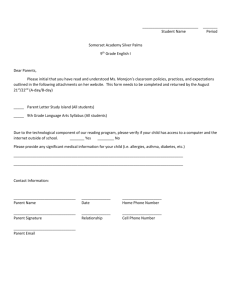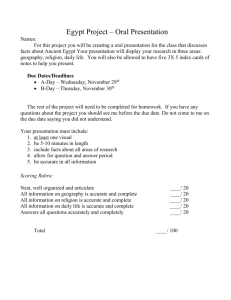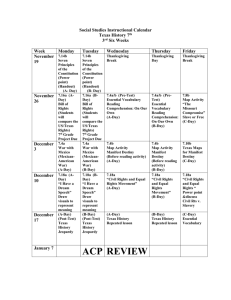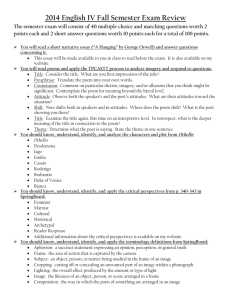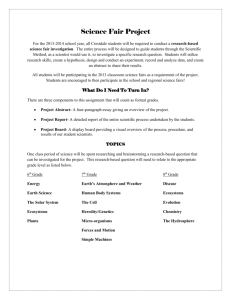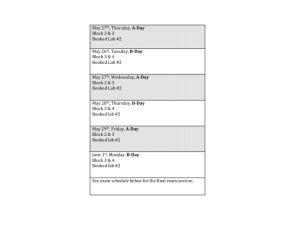HA & P *Do Now - LaffertysBiologyClass
advertisement
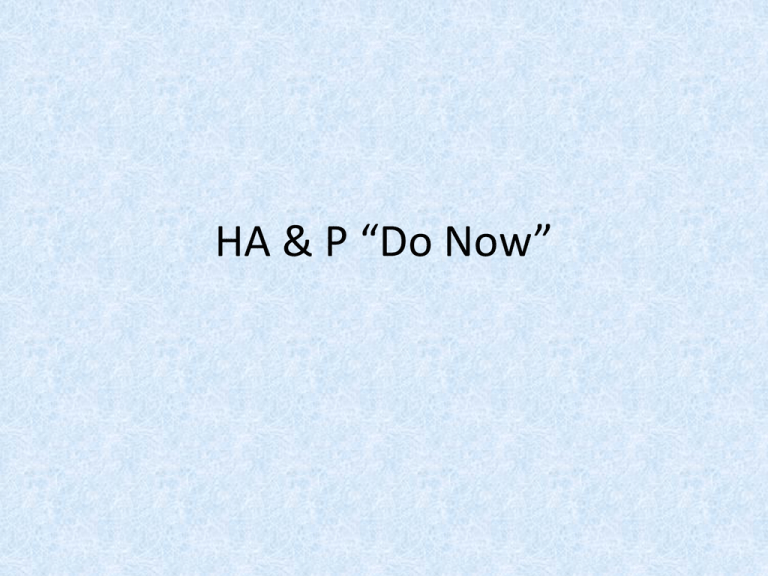
HA & P “Do Now” WELCOME BACK!!! • As you enter the classroom, pick up the necessary classroom materials that you will be using for the day. You can find these materials on the back counter under PICK-UP HA&P. Today, you will need “Syllabus” & “Get to know you”. • Complete the “Get to know you” document and turn it in to the turn-in bin which is located on my desk. • HOMEWORK: Parents are to read the syllabus and complete the bottom portion. Due: Thursday, Aug. 28th (10 points) WELCOME BACK!!! Tuesday, August 26th (A) • “Do Now” – Write your name on the blank piece of paper write the following question, “How do I succeed in Mrs. Lafferty’s class?” Answer this question. Tips to Be a Successful Student Wednesday, August 27th (A-day) • PICK-UP “Chap 1 Overview”, half a sheet of paper, along with a textbook. • Turn-in your signed syllabus: Deadline is tomorrow • On the half sheet of paper answer the following statement: “In your own words, define anatomy and physiology and describe how they are related? (5 sentence minimum). Thursday, August 28th (A-day) Careers in HA & P • Turn-in syllabus which is due today. • “Do Now” – Find a partner and think about what job you want to pick that relates to the field of human anatomy and physiology. Make sure you write your job at the top of rubric from yesterday. Tuesday, September 2nd (A-day) • “Do Now” – Pick up half sheet of paper and answer the following question: • Briefly describe the career that you choose and one thing that you learned while you were doing your research. Wednesday, Sept. 3rd (A-day) • Pick up Body Cavities, Organ System, half sheet of paper along with a textbook. • “Do Now” – What are the levels of organization within an organism? (HINT: Start at the atomic level and work your way up to organism.) Atom, molecules, macromolecules, cell, organelles, tissue, organs, organ systems and organism. Thursday, Sept. 4th (B-day) • Pick up body positions, sectioning and body lab organization along with a textbook. • “Do Now” – Name and briefly describe all organ systems of the body. DO NOT use textbook. Turn-in Monday, September 8th (A-day) • Pick Up Body Organization and Terminology worksheet along with a textbook. • “Do Now” – Turn to page 15 in textbook and complete body sections using Figure 1.13. Include a sagittal, coronal and transverse plane cuts on the Body Sections diagram and label. – Answer the following using your textbook: • What does a sagittal plane cut do? Coronal plane? Transverse plane? Tuesday, September 9th (A-day) • “Do Now” – Identify the following body regions: 5 1 6 2 7 3 4 8 1. Otic 2. Buccal 3. Oral 4. Mental 5. Cephalic 6. Orbital 7. Nasal 8. cervical Tuesday, September 16th (B-day) • Turn in Cell Review Packet • Pick up notes outline, table, half sheet of paper and a textbook. • “Do Now” – How do scientists organize the human body? Thursday, September 18th A-day • Pick up a textbook, half sheet paper and take out your membrane transport chart. • “Do Now” – List the 8 characteristics (properties) of life? (Do Not use your notes) Friday, September 19th (A-day) • Pick up DNA synthesis materials and turn-in Enzyme homework. • “Do Now” – Make a HA&P Journal on your iPad and enter your first entry by answer the following question: • Explain how organisms maintain their internal environment through membrane transport in paragraph form. Monday, Sept., 22nd (B-day) • Pick up cellular respiration worksheet, cartoon rubric and take out your Protein Synthesis Lab. • “Do Now” – Briefly explain how DNA goes from doublestranded DNA to a protein in paragraph form. Tuesday, Sept. 23rd (A-day) • Take out the overview of cellular respiration diagram. • “Do Now” – Answer the following • Why does every cell in our body need to undergo cellular respiration? Wednesday, Sept. 24th (A-day) • “Do Now” – Clinical application: (You can just answer question) • A husband and wife were having problems conceiving a child. The doctor determined that the husband has non-mobile sperm cells. A sperm cell is a single cell with a flagella that allows for movement. The doctor stated that enzymes responsible for cellular respiration in the cell are being destroyed which lead to nonmobility. Why are the sperm cells non-mobile? Thursday, September 25th A-day • “Do Now” – Name the types of epithelium and give an example of an organ from which they are from: • • • • • • • • Simple squamous – lungs Simple cuboidal – ovaries, kidneys Simple columnar – digestive system Pseudostratified columnar (ciliated) – lungs Stratified squamous – epidermis Stratified cuboidal – surrounding a lumen Stratified columnar – male urethra Transitional epthelium -bladder Thursday, September 26th A-day • “Do Now” – Name the 4 types of tissues and give an example of an organ from which they are from: • Epithelium – skin, lining of ducts, vessels of the respiratory, digestive, reproductive, etc. • Connective – support structures such as bone, cartilage, loose connective tissue, adipose, dense connective and blood • Muscle – cardiac, skeletal, smooth (intestinal tract) • Nervous – CNS and peripheral nervous system Monday, Sept., 29th (B-day) • Pick up Tissue Lab and take out Tissue Chart • “Do Now” – How do cells regulate the function of an organ system? (HINT: Think about what you learned in Chap 2,3&4) • Cellular level: breakdown of organic molecules in food, cell membrane transport, production of proteins through protein synthesis, production of energy through cellular respiration • Organ level: negative and positive feedback, signals from enzymes specific for one job Tuesday, Sept. 30th (B day) • Pick up Tissue Lab • “Dow Now” – What are the four main tissue types? Thursday, October 2nd (B-day) • Pick up a textbook and take out your tissue chart • “Do Now” – Identify the following tissue types: Adipose Dense connective tissue cardiac Smooth muscle Monday, October 6th (A-day) • Pick up textbook • “Do Now” – Describe the difference and similarities between simple squamous epithelium and stratified squamous epithelium in paragraph form. Tuesday, October 7th A-day • Turn-in Tissue Lab and prepare for quiz Wednesday, Oct. 8th (A-day) • “Do Now” – Identify the following tissue types: Adipose Dense connective tissue cardiac Smooth muscle Tuesday, October 14th (A-day) • Pick up a textbook and take out Skin and Integumentary System Notes • “Do Now” – What are the three layers of the skin? Wed., October 15th (B-day) • Pick up Integument Lab • I need one rubric from each presentation group. • “Do Now” – Airdrop your presentation if you haven’t already done so. Friday, October 17th (A-day) • “Do Now” – List tissues that you will find in the epidermis, dermis along with the subcutaneous layer of the integument: • Epidermis: blood vessels, stratified squamous epithelium, and melanocytes • Dermis: dense connective tissue, blood vessels, sweat glands, hair follicles • Subcutaneous layer: adipose tissue Incredible Human Machine - Skin Tuesday, October 21st (B-day) • Turn-in your review. • “Do Now” – How does the structure and function of the integument aid in human survival? Thursday, October 23th (A-day) • Pick up Skeletal notes and a textbook. • “Do Now” – What type of tissue make up bone and explain the difference between bone and cartilage? • • • • • Bone tissue (osteocytes) cartilage (chondrocytes: Hyaline, elastic, fibrocartilage) Dense connective tissue Blood Nervous tissue – Bone is most rigid connective tissue whereas cartilage is rigid connective tissue also but not as rigid. Friday, October 24th (A-day) • Take out the chicken lab and Bone Structure notes and pick up a textbook. • “Do Now” – What are the four functions of the skeletal system? • • • • Support and protection Body movement Blood cell formation Storage of inorganic salts
